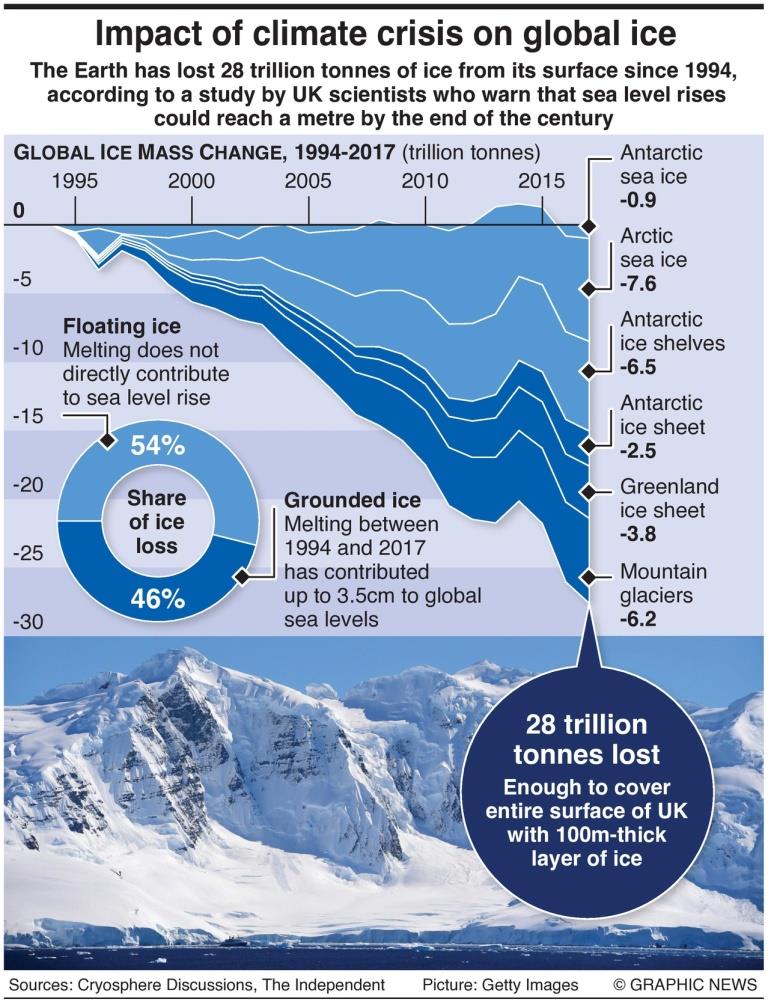As per a new study published in Earth’s Future regarding the unknown past, present, and future of our planet and its inhabitants, humans are bound to lose the frozen ground below their feet.
It has been found that the Earth’s overall cryosphere has shrunk by about 87,000 square kms or 33,000 square miles on an annual average, between 1979 and 2016 as a result of climate change.
This research has been the first in World to make an assessment of the complete surface area of the Earth covered by sea ice, snow cover or any frozen ground to be classified as cryosphere.
Existing data sets of global sea ice, snow cover, and permafrost were used to classify the planet’s surface divided into the grid by the authors of the study.
It has been the first to note the response of Cryosphere to warming temperatures.
Cryosphere: Have we heard about it?
“Kryos” meaning cold, are the frozen places of our planet, the places where water exhibits a solid form, wherein low temperatures freeze the available water and turn it into ice.
We tend to misinterpret cryosphere as being confined to the top and bottom of our planet i.e., in the polar regions but such snow or ice is also found at many other locations on Earth.
Frozen ground and permafrost encircle the Arctic Ocean. Within the ocean, sea ice tends to grow in winters and shrink in the summers.

An almost three-quarters of Earth’s fresh water is supplied by cryosphere worldwide as it is a source to great mountain rivers.
On the other side, Antarctica is a completely icy continent.
While in between the two extreme tropics, ‘altitudes’ on Earth have a tendency to behave like ‘latitudes.’
Mount Kilimanjaro lies in Africa, above the equator but hosts ice and snow, Mount Everest- the highest with permanent ice shelves and many more.
How this Cryosphere spurs life across the planet?
These innate colder regions of the planet influence our entire world’s climate and topography. So, what happens in our cryosphere, doesn’t just stay there.
Explains a physical geographer: “The cryosphere is one of the most sensitive climate indicators and the first one to demonstrate a changing world.”
Any change in the size or location of ice and snow can alter air temperatures, change the sea level and even affect ocean currents worldwide.
Global temperatures face a limitation through ice covers as its bright white surface possess greater ‘reflectivity’ or ‘Albedo’ of light. This avoids any extra warmth to be absorbed within the ice surface.
If this surface is reduced, lesser albedo means lesser amount of light gets reflected back and more absorption anyhow increases the ice to dissolve more.
Unlike our bleak sources about ice, many ecosystems and communities have made cryosphere their home and their lives seemingly depend on it.
Participants of the study have found that the average area covered by Earth’s cryosphere has undergone a severe contraction since 1979, that seems to be coinciding with rising air temperatures and changing climate.
Northern Hemisphere loss: Ice has primarily shrunk in the Northern Hemisphere, with a loss of about 102,000 square kms or 39,300 square miles per year.
Southern Hemisphere loss: Surprisingly, there has been cryosphere expansion by approximately 14,000 square kms or 5,400 square miles annually.
Sounds like an offset to the lost ice in North. It is likely due to the altering patterns of wind and ocean currents, consequently adding extra cold meltwater from Antarctic ice sheets.
Importance of such studies:
“This kind of analysis is a nice idea for a global index or indicator of climate change,” asserts a glaciologist. It could explain and help with many of the problems we faced so far.
The study has revealed that many regions now remain frozen for lesser time. On an average, the first day of freezing now occurs about 3.6 days later than in 1979, and the ice now melts off about 5.7 days earlier.
Increasing Albedo, shrinking ice sheets and snow cover, loss of Arctic sea ice, water scarcity (glaciers are the source of drinking water in many places) etc., is a sign that we cannot wait any longer.
NASA on Cryosphere:
On its website, lies a message: “Because of the importance of the cryosphere, NASA is committed to studying Earth’s ice extensively.”
Gravity Recovery and Climate Experiment satellite mission and the GRACE Follow-On, have helped to check any variation in such topography or ice sheet mass balance.
Operation IceBridge with 1000 flights to survey across the Arctic, Antarctica and Alaska for collecting details like height, depth, thickness, and even flow of sea ice, glaciers or ice sheets.
ICESat and ICESat-2 missions have taken this investigation to another level, showing how the warm ocean water erodes base of glaciers, causing the ice above it to break away from rest.
Presence in Himalayas: NASA’s High Mountain Asia Team has studied the Himalayas, Karakoram and Hindu Kush after changes observed in its glacial melt and precipitation patterns.
Everything on our planet — air, water, land and its inhabitants, is all connected through various chemical, physical and biological processes constituting, what we call the Earth system.
Such detailed studies are helpful in giving more insights into ecosystems, carbon exchange, plant and animal life cycles etc.
We have seen enough. Understanding the Nature makes anticipation easy and helps to avert greater disasters in future.


